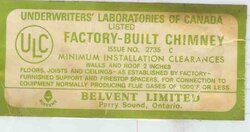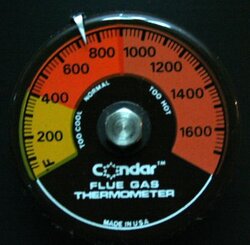JIMBOB: Stated that it wouldnt be safe?
Safe in the sense if there was a chimney fire, which would only happen if I didnt clean the chimney and allow for buildup.
From my previous post here is a copy from the FROM THE NFPA 211 STANDARDS . This states that all chimneys of today are rated for 1000 Degrees. Does it mean my chimney was tested for UL103, probably not. But it appears that most is rated for 1000 Deg F with the 10 minute test of 3 intervals at 1700 Deg F.
3.2.17.3 Chimney, Factory-Built, Residential Type and Building Heating
Appliance Type.
A chimney suitable for use at 1000°F (538°C), which
complies with the 10-minute 1700°F temperature test of UL103, Standard
for Safe Chimneys, Factory-Built, Residential Type and Building Heating
Appliance and is composed of listed, factory-built components that might
be fully enclosed in combustible, residential type construction, and that is
assembled in accordance with the terms of the listing to form a completed
chimney.
3.2.17.4* Chimney, Factory-Built, Residential Type and/or Building
Heating Appliance Type—Type HT.
A residential type and building heating
appliance chimney suitable for use at 1000°F (538°C), which complies with
the optional 10-minute 2100°F temperature test of UL103, Standard for Safe
Chimneys, Factory-Built, Residential Type and Building Heating Appliance.
Such chimneys are labeled as Type HT and are required for certain solid
fuel- fired applications (see Section 3-1.2)
FROM THE NFPA 211 STANDARDS PLEASE LOOK AT MY LABEL THAT I HAVE SCANNED FROM MY CHIMNEY AND MAYBE YOU CAN HELP ME OUT.....
3.2.17.3 Chimney, Factory-Built, Residential Type and Building Heating
Appliance Type. A chimney suitable for use at 1000°F (538°C), which
complies with the 10-minute 1700°F temperature test of UL103, Standard
for Safe Chimneys, Factory-Built, Residential Type and Building Heating
Appliance and is composed of listed, factory-built components that might
be fully enclosed in combustible, residential type construction, and that is
assembled in accordance with the terms of the listing to form a completed
chimney.
3.2.17.4* Chimney, Factory-Built, Residential Type and/or Building
Heating Appliance Type—Type HT. A residential type and building heating
appliance chimney suitable for use at 1000°F (538°C), which complies with
the optional 10-minute 2100°F temperature test of UL103, Standard for Safe
Chimneys, Factory-Built, Residential Type and Building Heating Appliance.
Such chimneys are labeled as Type HT and are required for certain solid
fuel- fired applications (see Section 3-1.2)
Attached is a copy of the sticker via this link of my last posting......... The company is not longer around.
https://www.hearth.com/econtent/index.php/forums/viewthread/11060/#127354
Hope to hear some comments....
Thanks



